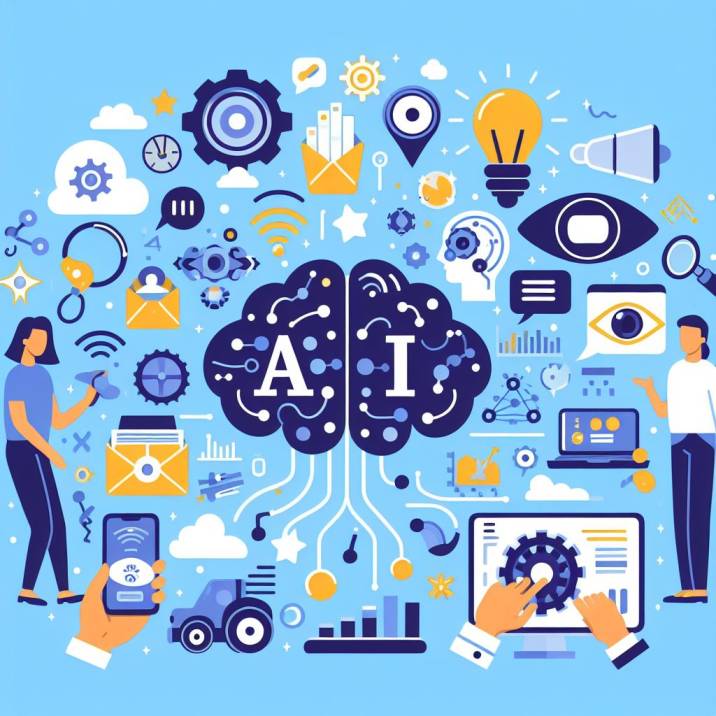Free consultation

AI: Empowering Growth, Streamlining Operations, and Shaping Tomorrow's Jobs Today
Artificial intelligence (AI) and machine learning (ML) are transforming the way businesses operate and interact with customers. In this blog post, we will explore how AI and ML are being used in various industries and functions, and why they are essential for the future of work, while debunking unfounded fears of job displacement.
AI and ML are not new concepts. They have been around for decades, but they have gained more prominence in recent years due to the availability of massive amounts of data, powerful computing resources, and advanced algorithms.
AI refers to the ability of machines to perform tasks that normally require human intelligence, such as reasoning, learning, decision making, and natural language processing. ML is a subset of AI that enables machines to learn from data and improve their performance without explicit programming.
Cutting through the tech jargon, let's focus on tangible business benefits:

- Boosting efficiency through process automation: AI and ML can automate repetitive and mundane tasks, such as data entry, invoicing, scheduling, customer service, etc., freeing up human workers for more creative and strategic work.
- Improving the speed or consistency of service: AI and ML can provide faster and more accurate responses to customer queries, requests, or complaints, using chatbots, voice assistants, or sentiment analysis. They can also optimize workflows, logistics, inventory management, supply chain operations, etc., using predictive analytics, optimization algorithms, or computer vision.
- Using customer insights to inform decision-making: AI and ML can analyse large volumes of customer data, such as preferences, behaviour, feedback, etc., to generate insights that can help businesses tailor their products, services, marketing campaigns, pricing strategies, etc., to meet customer needs and expectations.
- Uncovering opportunities for new products and services: AI and ML can help businesses discover new patterns, trends, or gaps in the market, using data mining, deep learning, or natural language processing. They can also help businesses innovate and create new solutions, using generative models, reinforcement learning, or neural networks.
Dispelling Misconceptions:
One of the common fears associated with AI and ML is that they will replace human workers and cause unemployment. However, this fear is unwarranted and based on a misunderstanding of the nature and purpose of AI and ML. AI and ML are not meant to replace humans, but to augment them and enable them to do their work better, faster, and more efficiently. For example, the industrial revolution introduced machines and computers that replaced some human tasks but also created new jobs and industries that improved productivity and living standards.
Similarly, the current AI revolution will create new possibilities and demands for society that will require humans to adapt and evolve. In fields like healthcare, AI complements human expertise, enhancing diagnostics and improving overall outcomes. It's a collaborative effort, not a competition.
Some examples of how AI and ML are being used in different industries and functions are:

- Healthcare: AI and ML are being used to diagnose diseases, recommend treatments, monitor patients' health, discover new drugs, etc., using image recognition, natural language processing, or deep learning.
- Education: AI and ML are being used to personalize learning experiences, assess students' progress, provide feedback, tutor students, etc., using adaptive learning systems, natural language processing, or computer vision.
- Finance: AI and ML are being used to detect frauds, manage risks, provide financial advice, trade stocks, etc., using anomaly detection, natural language processing, or reinforcement learning.
- Retail: AI and ML are being used to recommend products, optimize prices, forecast demand, manage inventory, etc., using collaborative filtering, optimization algorithms, or predictive analytics.
- Entertainment: AI and ML are being used to create content, recommend content, enhance content quality, etc., using generative models, natural language processing, or computer vision.
Embracing Change:
The key takeaway here is adaptation. Businesses that embrace technological advancements gain a competitive edge. Businesses should also invest in reskilling/upskilling their workforce to prepare them for the future of work that will require more creativity, critical thinking, and collaboration skills.
For our readers, it means acknowledging the transformative potential of AI and ML, understanding how they align with your goals, and preparing for a future where innovation drives success.

Real-World Solutions for You:
Beyond the industry hype, we're committed to providing practical solutions for your business. AI and ML aren't just buzzwords; they're tools designed to simplify complexities and enhance efficiency.
It's about addressing real-world challenges faced by business owners like you. In closing, consider this a friendly invitation to explore the possibilities that AI and ML present for your business. Our commitment is to navigate the tech landscape alongside you, offering tailored solutions that leverage these technologies to make your business operations smoother and more effective. The future is bright, and we're here to guide you through it.